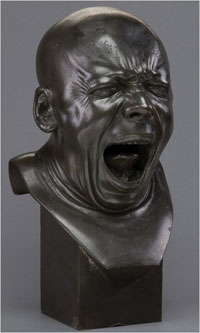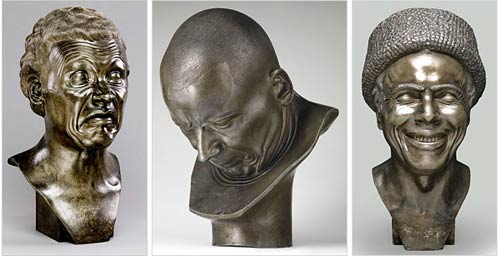
 Sculpture News at SculptSite.com
Sculpture News at SculptSite.com
Franz Xaver Messerschmid Sculpture |
 Museum of Fine Arts, Budapest Franz Xavier Messerschmidt: "The Yawner" is in the exhibition at the Neue Galerie. |
| The New York Times By HOLLAND COTTER ART REVIEW Odd Faces, Strange in Their Day, but Familiar in Our Time"Anything great in this world has come from neurotics," Marcel Proust wrote. He could easily have been referring to a string of manic, morose and sometimes quite mad artists who came and went over the centuries, creating a popular impression that creativity and craziness were inextricably linked. Psychological quirks clearly shaped artists' careers long before van Gogh was on the scene. A detail-freak streak in Leonardo da Vinci's personality led him to leave many projects unfinished. The 16th-century painter Federico Barocci was plagued by a psychosomatic malaise so crippling that for 50 years he worked only two hours a day and spent the rest of the time, in agony, in bed. (He must have worked extra-hard in those hours because he turned out a lot of product.) Leonardo and Barocci got off lightly, though, compared with suicidal peers. The Mannerist painter Francesco Bassano, in a frenzy of paranoia (he thought the police were after him), jumped out a window and died. The Dutch artist Emanuel de Witte, best known for his immaculate church interiors, is thought to have drowned himself. The architect Francesco Borromini, damned by a critic as "a complete ignoramus, a corrupter of architecture, and the shame of our century," ended it all with a sword. To the annals of aesthetic pathology we can also add the slightly milder case of the 18th-century German sculptor Franz Xaver Messerschmidt, who is the subject of a small but potent retrospective at the Neue Galerie. As was not necessarily true of the artists mentioned above, his mental disturbance manifested itself in his art, specifically in a series of bizarrely conceived busts known as character heads. Among the more outlandish artifacts of the Age of Reason, 19 of these sculptures have been brought together for the show "Franz Xaver Messerschmidt 1736-1783: From Neoclassicism to Expressionism," which has been organized in collaboration with the Louvre and travels to Paris from New York. Messerschmidt was born in a small town in Bavaria and trained as a journeyman sculptor in Munich. At 18 he was at the Academy of Fine Arts in Vienna, where he caught the eye of its director, Martin van Meytens, who was also official painter to the Habsburg court. Thanks to van Meytens's advocacy, the brilliant young sculptor soon had commissions for imperial portraits, including two of the Empress Maria Theresa. Wanting further experience, he traveled to Rome to immerse himself in antiquities, paying particular attention to Roman Republican portraiture. After this, like most enterprising Enlightenment artists, he shifted his style from a Baroque-Rococo mélange to Neo-Classicism, evident in two of the earliest portraits in the show. One, in cast metal, depicts the Viennese art theorist Franz von Scheyb, a close friend of van Meytens. The other, carved from alabaster, is of Gerard van Swieten, Maria Theresa's physician. In both portraits, the Baroque coiffeurs and draperies are stripped away. In their place we have, in a new plain style, unglamorous, face-forward images of two not-young, not-beautiful men looking much as they must have looked in life. Around the time of these busts, Messerschmidt was hired to teach at the academy, with the understanding that he would inherit the position of professor of sculpture once a senior colleague had retired. A bright future seemed assured. Then everything went awry, as damaging rumors circulated that he was mentally unbalanced. Academic politics can't be discounted, especially after his champion, van Meytens, died. But Messerschmidt's personality, commandingly idiosyncratic, had always set him apart, and by the early 1770s his eccentricities were more pronounced. Possibly after contact with secret societies, of a sort that proliferated at the time like a return of a Gothic repressed, he was having hallucinations, seeing ghosts. Commissions dried up. When the academy professorship became available, it went to someone else. In anger he rejected the compensatory offering of a pension and left Vienna for good. After some wandering he ended up not far from Vienna in 1777 in the city now called Bratislava, where he crashed with a younger brother, then found a home and studio of his own. In Vienna he had already begun producing his slightly larger-than-life and entirely self-commissioned "character heads." In Bratislava he made many more. Some are obviously self-portraits; others may have been modeled on specific sitters, and still others are fanciful. Nearly all are marked by facial contortions. In one self-portrait cast in tin — an inexpensive and easily worked metal — Messerschmidt is wearing a Bratislava-style sheepskin cap and grinning so strenuously that his eyes are all but buried in folds of flesh. In a second self-portrait the aggressive hilarity is gone; his features are bunched and twisted in a look of tearful, abject fear. In a third, he gives a vehement scowl, under thick, soldered-on eyebrows. This bust had traditionally been called "A Surly Old Soldier," but none of the titles on the heads are by Messerschmidt himself. They were added after his death, and most seem descriptively inaccurate. A sculpture of a shaven-headed man with tightly shut eyes and a stretched-open mouth is called "The Yawner," though he seems to be screaming. And the moralizing label of "A Hypocrite and Slanderer" has little pertinence to the image of an elderly figure staring downward, his chin pressed into a collar of fleshly wrinkles at his neck, as if he were lost, even trapped in profound self-reflection. In 1781 the staid but dauntless journalist Friedrich Nicolai visited Messerschmidt and asked him what had inspired the sculptures. The artist explained that he was periodically tormented by malign spirits, the most frightful of which he called the spirit of proportion. But if he greeted them with sculptural expressions of extreme emotions, the spirits could be kept at bay. (Had he told the same story to anyone back in Vienna? If so, that might explain a lot.) It's tempting to view Messerschmidt in Bratislava as an outsider, isolated, strictly on his own track. But this wasn't so. His reputation as a former sculptor to the Viennese court brought him a prestigious new clientele, so that at the same time he was creating his character heads, he was working on commissions for aristocratic portraits. These late portraits are a fascinating combination of accuracy and exaggeration. He depicts Duke Albert of Saxe-Teschen, one of Maria Theresa's sons-in-law, with flaring Norma Desmond eyes and a chin so large as to verge on being abnormal, like the protruding upper lip in his own "Beak Heads." Messerschmidt's 1782 image of the Enlightenment historian Martin Georg Kovachich is even more forcefully expressive. With its large, swollen features and scowl-creased forehead, it seems to be shoving its way through space. In the Kovachich portrait, Messerschmidt welded together, much in the way his near-contemporary Francisco Goya did, two sides of his identity as an artist, the public and the private, the realist and the visionary. In the character heads, he had long been doing the same. After his death, at 47, a group of more than 40 of these busts were sold en masse, shipped to Vienna and exhibited, accompanied by added names and a brochure, as a freak-show attraction in a carnival. Then gradually, with changes in taste, one by one they entered private collections, then museums, being valued most recently as precursors to the early-20th-century German Expressionist painting that is a Neue Galerie specialty. They fit effortlessly into the context of a contemporary art that encompasses images of physiognomic distortion by artists like Bruce Nauman, Tony Oursler, Arnulf Rainer, Cindy Sherman, Ashley Bickerton and Keith Edmier, among many others. (Mr. Edmier has made a limited-edition sculpture based on a Messerschmidt head to accompany the show.) And Messerschmidt's sculptures, which once struck audiences as alien and nuts, simply make some human sense in our century, when everyone could use some psychotherapy. Even the uptight Nicolai eventually became comfortable with his reclusive subject's art. The journalist kept a portrait bust that Messerschmidt made of him on his work desk for the rest of his life, in memory, he wrote, "of a strange and really great artist." Proust might not have agreed with this evaluation, but he understood that the descriptive terms can be one and the same. "Franz Xaver Messerschmidt 1736-1783: From Neoclassicism to Expressionism" remains though Jan. 10 at the Neue Galerie New York, 1048 Fifth Avenue, at 86th Street; neuegalerie.org. |
 The Marcel Proust quote, "Anything great in this world has come from neurotics," speaks volumes! Holland Cotter who wrote this wonderful expose on Franz Xaver Messerschmid hit the nail on right on the head, so to speak. In addition, Mr. Cotter also titled the article quite well! Sculptors and their sculpture again facing the test of time and passing with flying colors. Messerschmidt's work, well it's hard to stop looking at it and feeling even after all these years... |
 |
| From left: Museum of Fine Arts, Budapest; Metropolitan Museum of Art; Private Collection, Belgium Nearly all of Franz Xaver Messerschmidt's portraits are marked by facial distortions. From left, his self-portrait cast in tin, "The Artist as He Imagined Himself Laughing"; "A Hypocrite and Slanderer"; and "Childish Weeping." None of the titles are by Messerschmidt himself; they were added after his death. |
More Sculpture News ....
Submit your SCULPTURE NEWS.
It's easy, just send us an e-mail
(click on Submit News in the left menu) with your pertinent information along with images, we'll take care of the rest. Sculpture makes our world a much better place in so many ways!
SculptSite.com, along with Sculptors and their creative genius all helping to bring the beauty and message of Sculpture to a hurried world.

